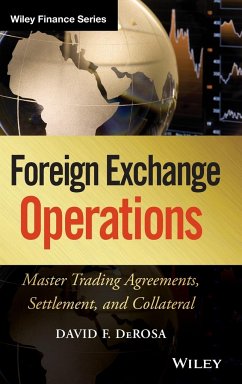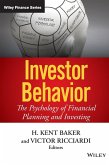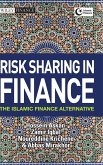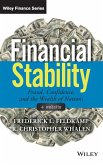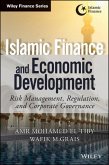David F. DeRosa
Foreign Exchange Operations
David F. DeRosa
Foreign Exchange Operations
- Gebundenes Buch
- Merkliste
- Auf die Merkliste
- Bewerten Bewerten
- Teilen
- Produkt teilen
- Produkterinnerung
- Produkterinnerung
The ultimate nuts-and-bolts guide to foreign exchange operations
The foreign exchange landscape is particularly risky since so much of the world is unregulated and takes place over the counter (off exchange). Brilliant traders and money managers who are profitable may find themselves underperforming, or worse, losing, simply because they failed to establish strong operations. In this book, David DeRosa provides industry players with everything they need for strong operational functions from all the types of trades to execution, master trading agreements, documentation, settlement, margin…mehr
Andere Kunden interessierten sich auch für
![Investor Behavior Investor Behavior]() H. Kent BakerInvestor Behavior106,99 €
H. Kent BakerInvestor Behavior106,99 €![Global Pension Crisis Global Pension Crisis]() Richard A. MarinGlobal Pension Crisis46,99 €
Richard A. MarinGlobal Pension Crisis46,99 €![Family Enterprise Family Enterprise]() The Family Firm Institute IncFamily Enterprise84,99 €
The Family Firm Institute IncFamily Enterprise84,99 €![Contribution Plans Contribution Plans]() Stacy SchausContribution Plans57,99 €
Stacy SchausContribution Plans57,99 €![Risk Sharing in Finance Risk Sharing in Finance]() Zamir IqbalRisk Sharing in Finance113,99 €
Zamir IqbalRisk Sharing in Finance113,99 €![Financial Stability, + Website Financial Stability, + Website]() Frederick L. FeldkampFinancial Stability, + Website72,99 €
Frederick L. FeldkampFinancial Stability, + Website72,99 €![Islamic Finance and Economic Development Islamic Finance and Economic Development]() Amr Mohamed El Tiby AhmedIslamic Finance and Economic Development80,99 €
Amr Mohamed El Tiby AhmedIslamic Finance and Economic Development80,99 €-
-
-
The ultimate nuts-and-bolts guide to foreign exchange operations
The foreign exchange landscape is particularly risky since so much of the world is unregulated and takes place over the counter (off exchange). Brilliant traders and money managers who are profitable may find themselves underperforming, or worse, losing, simply because they failed to establish strong operations. In this book, David DeRosa provides industry players with everything they need for strong operational functions from all the types of trades to execution, master trading agreements, documentation, settlement, margin and collateral, and prime brokerage services.
Contains vital work flow solutions for trading in the volatile foreign exchange marketplace
Offers information for mastering the operational aspect of foreign exchange trading to help determine best partners such as prime brokers and others
Written by David DeRosa a leading foreign exchange expert who has consulted to hundreds of financial institutions
Foreign Exchange Operations helps traders mitigate risks and offers a guide to all aspects of trading operations from mastering trading agreements to margin documentation.
Hinweis: Dieser Artikel kann nur an eine deutsche Lieferadresse ausgeliefert werden.
The foreign exchange landscape is particularly risky since so much of the world is unregulated and takes place over the counter (off exchange). Brilliant traders and money managers who are profitable may find themselves underperforming, or worse, losing, simply because they failed to establish strong operations. In this book, David DeRosa provides industry players with everything they need for strong operational functions from all the types of trades to execution, master trading agreements, documentation, settlement, margin and collateral, and prime brokerage services.
Contains vital work flow solutions for trading in the volatile foreign exchange marketplace
Offers information for mastering the operational aspect of foreign exchange trading to help determine best partners such as prime brokers and others
Written by David DeRosa a leading foreign exchange expert who has consulted to hundreds of financial institutions
Foreign Exchange Operations helps traders mitigate risks and offers a guide to all aspects of trading operations from mastering trading agreements to margin documentation.
Hinweis: Dieser Artikel kann nur an eine deutsche Lieferadresse ausgeliefert werden.
Produktdetails
- Produktdetails
- Wiley Finance Series
- Verlag: Wiley & Sons
- 1. Auflage
- Seitenzahl: 416
- Erscheinungstermin: 28. Oktober 2013
- Englisch
- Abmessung: 235mm x 157mm x 27mm
- Gewicht: 750g
- ISBN-13: 9780470932919
- ISBN-10: 0470932910
- Artikelnr.: 38129626
- Herstellerkennzeichnung
- Libri GmbH
- Europaallee 1
- 36244 Bad Hersfeld
- gpsr@libri.de
- Wiley Finance Series
- Verlag: Wiley & Sons
- 1. Auflage
- Seitenzahl: 416
- Erscheinungstermin: 28. Oktober 2013
- Englisch
- Abmessung: 235mm x 157mm x 27mm
- Gewicht: 750g
- ISBN-13: 9780470932919
- ISBN-10: 0470932910
- Artikelnr.: 38129626
- Herstellerkennzeichnung
- Libri GmbH
- Europaallee 1
- 36244 Bad Hersfeld
- gpsr@libri.de
David F. DeRosa is President of DeRosa Research and Trading, Inc., a firm that conducts research into derivatives pricing, macroeconomics, monetary policy, and foreign exchange. He is an adjunct associate professor of finance at the Fu Foundation School of Engineering and Applied Science at Columbia University where he teaches courses in pricing models in financial engineering. David sits on the boards of several prominent hedge fund groups. He is the author of many books including Options on Foreign Exchange (Wiley), Central Banking and Monetary Policy in Emerging-Markets Nations, and In Defense of Free Capital Markets. David received his PhD in finance and economics from the Graduate School of Business of The University of Chicago, and his BA in economics from the College of The University of Chicago. Before founding DeRosa Research, he worked on Wall Street as a foreign exchange trader, hedge fund trader, and portfolio manager.
Preface xi
Acknowledgments xv
CHAPTER 1 Introduction to Foreign Exchange 1
Defining Money 1
Participants in the Foreign Exchange Market 2
Identifying Currencies and Exchange Rates 4
Quotation Conventions 5
The Foreign Exchange Market 6
Foreign Exchange Regimes 11
Exchange Rate Controls 12
The Structure of the Foreign Exchange Market 12
Banks' Identification Codes 13
The Authorities 15
Spot Foreign Exchange Deals 17
Profit and Loss on a Simple Trade 18
Value Dates 19
Forward Foreign Exchange and Covered Interest Parity 20
Forward Swaps 21
Non-Deliverable Forwards 22
Summary 22
Appendix 1.1: ISO Currency Codes 23
References 34
CHAPTER 2 Options on Foreign Exchange 35
Option Basics 35
Put-Call Parity 37
The Importance of Option Models 39
Risk Parameters 41
The Minor Greeks 44
More on Delta 45
Portfolios of Options 50
American Exercise Models 51
Volatility 52
Important Option Strategies 55
Option Market Making 56
Non-Deliverable Options 56
Barrier Options 58
Binary Options 65
Barrier Determination Agency 69
Other Exotic Options 70
More on Option-Related Risks 70
Summary 72
Appendix 2.1: Further Comments on Put-Call Parity 72
Appendix 2.2: Black-Scholes-Merton Model 74
Appendix 2.3: Barrier and Binary Options 75
References 78
CHAPTER 3 How Trades are Executed and Confirmed 81
Spot Foreign Exchange Deals 83
Forward Outright Deals 83
Forward Swap Deals 85
Option Trades 87
How Foreign Exchange Trades are Executed 88
Concentration in Market Making 89
Example of an Electronic Trading Platform: FXall 92
Trade Documentation Cycle 97
Internal Operations and Reports for Dealers 141
Summary 159
Appendix 3.1: Transactions at Daily Fixings 160
References 160
CHAPTER 4 Foreign Exchange Settlement 161
Settlement Instructions for an Individual Spot Foreign Exchange Deal 161
Overview of the Settlement Process 170
The Bretton Woods-Smithsonian Period 171
The Herstatt Legacy 172
Settlement Risk 173
Netting 176
How the Modern Settlement Systems Developed 181
Large-Value Transfers 186
Central Bank Involvement 186
Correspondent Banking 187
Payment Systems 187
Designated-Time Net Settlement (DTNS) 189
Real-Time Gross Settlement (RTGS) 189
Examples of Modern Payment Systems 192
CLS Bank International 203
Internal Controls 208
Summary 209
References 209
CHAPTER 5 Master Agreements 211
Motivation 212
The Architecture 214
The FXC Master Agreement Forms 215
The ISDA Master Agreement Forms 215
Single Agreement 217
Non-Reliance: Parties to Rely on Their Own Expertise 219
Netting: Payment or Settlement Netting and Novation Netting 220
Events of Default 221
Termination Events 228
Additional Termination Events 230
Close-Out Netting 231
Safe Harbors 232
Early Termination 233
Payments Upon Termination and Close-Out Amounts 234
Close-Out Amount: 2002 ISDA 236
Set-Off Provisions 241
Special Features for Options: ICOM and FEOMA 241
Special Features for Non-Deliverable Forwards 242
Miscellaneous Issues 242
More on Deeds of Adherence and Schedules 245
Summary 245
Appendix 5.1: IFXCO Terms 246
Appendix 5.2: IFXCO Adherence Agreement 275
References 281
CHAPTER 6 Margin and Collateral 283
Credit Agreements 283
Framework for the ISDA Credit Support Deed and the FXC Collateral Annex 285
Framework for the ISDA Credit Support Annexes 293
Enforcement Rights of the Secured Party 294
Some Additional Features Commonly Found in Credit Support Documents 296
The Value-at-Risk Concept 297
VaR for Spot, Forward, and Vanilla Options 298
Portfolio Value-at-Risk 305
Sample Customer Credit Snapshot 310
Limitations of VaR 310
Limitations of Collateralized Agreements 313
Summary 313
Appendix 6.1: The 1999 Collateral Annex to FEOMA, IFEMA, or ICOM Master
Agreement 314
References 337
CHAPTER 7 Foreign Exchange Prime Brokerage 339
Overview of FX Prime Brokerage 339
Pros and Cons of FX Prime Brokerage 341
Execution and Confirmation in an FX Prime Brokerage Environment 343
The Legal Architecture of FX Prime Brokerage 345
The FX Prime Broker and the Executing Dealer 346
The Master FX Give-up Agreement 346
Other Elements of the Master FX Give-up Agreement 354
The FX Prime Broker and the Designated Party 359
The Executing Dealer and the Designated Party 366
Reverse Give-Up Relationships 366
Summary 368
Appendix 7.1: Master FX Give-Up Agreement 369
Appendix 7.2: Compensation Agreement 384
References 388
About the Author 389
Index 391
Acknowledgments xv
CHAPTER 1 Introduction to Foreign Exchange 1
Defining Money 1
Participants in the Foreign Exchange Market 2
Identifying Currencies and Exchange Rates 4
Quotation Conventions 5
The Foreign Exchange Market 6
Foreign Exchange Regimes 11
Exchange Rate Controls 12
The Structure of the Foreign Exchange Market 12
Banks' Identification Codes 13
The Authorities 15
Spot Foreign Exchange Deals 17
Profit and Loss on a Simple Trade 18
Value Dates 19
Forward Foreign Exchange and Covered Interest Parity 20
Forward Swaps 21
Non-Deliverable Forwards 22
Summary 22
Appendix 1.1: ISO Currency Codes 23
References 34
CHAPTER 2 Options on Foreign Exchange 35
Option Basics 35
Put-Call Parity 37
The Importance of Option Models 39
Risk Parameters 41
The Minor Greeks 44
More on Delta 45
Portfolios of Options 50
American Exercise Models 51
Volatility 52
Important Option Strategies 55
Option Market Making 56
Non-Deliverable Options 56
Barrier Options 58
Binary Options 65
Barrier Determination Agency 69
Other Exotic Options 70
More on Option-Related Risks 70
Summary 72
Appendix 2.1: Further Comments on Put-Call Parity 72
Appendix 2.2: Black-Scholes-Merton Model 74
Appendix 2.3: Barrier and Binary Options 75
References 78
CHAPTER 3 How Trades are Executed and Confirmed 81
Spot Foreign Exchange Deals 83
Forward Outright Deals 83
Forward Swap Deals 85
Option Trades 87
How Foreign Exchange Trades are Executed 88
Concentration in Market Making 89
Example of an Electronic Trading Platform: FXall 92
Trade Documentation Cycle 97
Internal Operations and Reports for Dealers 141
Summary 159
Appendix 3.1: Transactions at Daily Fixings 160
References 160
CHAPTER 4 Foreign Exchange Settlement 161
Settlement Instructions for an Individual Spot Foreign Exchange Deal 161
Overview of the Settlement Process 170
The Bretton Woods-Smithsonian Period 171
The Herstatt Legacy 172
Settlement Risk 173
Netting 176
How the Modern Settlement Systems Developed 181
Large-Value Transfers 186
Central Bank Involvement 186
Correspondent Banking 187
Payment Systems 187
Designated-Time Net Settlement (DTNS) 189
Real-Time Gross Settlement (RTGS) 189
Examples of Modern Payment Systems 192
CLS Bank International 203
Internal Controls 208
Summary 209
References 209
CHAPTER 5 Master Agreements 211
Motivation 212
The Architecture 214
The FXC Master Agreement Forms 215
The ISDA Master Agreement Forms 215
Single Agreement 217
Non-Reliance: Parties to Rely on Their Own Expertise 219
Netting: Payment or Settlement Netting and Novation Netting 220
Events of Default 221
Termination Events 228
Additional Termination Events 230
Close-Out Netting 231
Safe Harbors 232
Early Termination 233
Payments Upon Termination and Close-Out Amounts 234
Close-Out Amount: 2002 ISDA 236
Set-Off Provisions 241
Special Features for Options: ICOM and FEOMA 241
Special Features for Non-Deliverable Forwards 242
Miscellaneous Issues 242
More on Deeds of Adherence and Schedules 245
Summary 245
Appendix 5.1: IFXCO Terms 246
Appendix 5.2: IFXCO Adherence Agreement 275
References 281
CHAPTER 6 Margin and Collateral 283
Credit Agreements 283
Framework for the ISDA Credit Support Deed and the FXC Collateral Annex 285
Framework for the ISDA Credit Support Annexes 293
Enforcement Rights of the Secured Party 294
Some Additional Features Commonly Found in Credit Support Documents 296
The Value-at-Risk Concept 297
VaR for Spot, Forward, and Vanilla Options 298
Portfolio Value-at-Risk 305
Sample Customer Credit Snapshot 310
Limitations of VaR 310
Limitations of Collateralized Agreements 313
Summary 313
Appendix 6.1: The 1999 Collateral Annex to FEOMA, IFEMA, or ICOM Master
Agreement 314
References 337
CHAPTER 7 Foreign Exchange Prime Brokerage 339
Overview of FX Prime Brokerage 339
Pros and Cons of FX Prime Brokerage 341
Execution and Confirmation in an FX Prime Brokerage Environment 343
The Legal Architecture of FX Prime Brokerage 345
The FX Prime Broker and the Executing Dealer 346
The Master FX Give-up Agreement 346
Other Elements of the Master FX Give-up Agreement 354
The FX Prime Broker and the Designated Party 359
The Executing Dealer and the Designated Party 366
Reverse Give-Up Relationships 366
Summary 368
Appendix 7.1: Master FX Give-Up Agreement 369
Appendix 7.2: Compensation Agreement 384
References 388
About the Author 389
Index 391
Preface xi
Acknowledgments xv
CHAPTER 1 Introduction to Foreign Exchange 1
Defining Money 1
Participants in the Foreign Exchange Market 2
Identifying Currencies and Exchange Rates 4
Quotation Conventions 5
The Foreign Exchange Market 6
Foreign Exchange Regimes 11
Exchange Rate Controls 12
The Structure of the Foreign Exchange Market 12
Banks' Identification Codes 13
The Authorities 15
Spot Foreign Exchange Deals 17
Profit and Loss on a Simple Trade 18
Value Dates 19
Forward Foreign Exchange and Covered Interest Parity 20
Forward Swaps 21
Non-Deliverable Forwards 22
Summary 22
Appendix 1.1: ISO Currency Codes 23
References 34
CHAPTER 2 Options on Foreign Exchange 35
Option Basics 35
Put-Call Parity 37
The Importance of Option Models 39
Risk Parameters 41
The Minor Greeks 44
More on Delta 45
Portfolios of Options 50
American Exercise Models 51
Volatility 52
Important Option Strategies 55
Option Market Making 56
Non-Deliverable Options 56
Barrier Options 58
Binary Options 65
Barrier Determination Agency 69
Other Exotic Options 70
More on Option-Related Risks 70
Summary 72
Appendix 2.1: Further Comments on Put-Call Parity 72
Appendix 2.2: Black-Scholes-Merton Model 74
Appendix 2.3: Barrier and Binary Options 75
References 78
CHAPTER 3 How Trades are Executed and Confirmed 81
Spot Foreign Exchange Deals 83
Forward Outright Deals 83
Forward Swap Deals 85
Option Trades 87
How Foreign Exchange Trades are Executed 88
Concentration in Market Making 89
Example of an Electronic Trading Platform: FXall 92
Trade Documentation Cycle 97
Internal Operations and Reports for Dealers 141
Summary 159
Appendix 3.1: Transactions at Daily Fixings 160
References 160
CHAPTER 4 Foreign Exchange Settlement 161
Settlement Instructions for an Individual Spot Foreign Exchange Deal 161
Overview of the Settlement Process 170
The Bretton Woods-Smithsonian Period 171
The Herstatt Legacy 172
Settlement Risk 173
Netting 176
How the Modern Settlement Systems Developed 181
Large-Value Transfers 186
Central Bank Involvement 186
Correspondent Banking 187
Payment Systems 187
Designated-Time Net Settlement (DTNS) 189
Real-Time Gross Settlement (RTGS) 189
Examples of Modern Payment Systems 192
CLS Bank International 203
Internal Controls 208
Summary 209
References 209
CHAPTER 5 Master Agreements 211
Motivation 212
The Architecture 214
The FXC Master Agreement Forms 215
The ISDA Master Agreement Forms 215
Single Agreement 217
Non-Reliance: Parties to Rely on Their Own Expertise 219
Netting: Payment or Settlement Netting and Novation Netting 220
Events of Default 221
Termination Events 228
Additional Termination Events 230
Close-Out Netting 231
Safe Harbors 232
Early Termination 233
Payments Upon Termination and Close-Out Amounts 234
Close-Out Amount: 2002 ISDA 236
Set-Off Provisions 241
Special Features for Options: ICOM and FEOMA 241
Special Features for Non-Deliverable Forwards 242
Miscellaneous Issues 242
More on Deeds of Adherence and Schedules 245
Summary 245
Appendix 5.1: IFXCO Terms 246
Appendix 5.2: IFXCO Adherence Agreement 275
References 281
CHAPTER 6 Margin and Collateral 283
Credit Agreements 283
Framework for the ISDA Credit Support Deed and the FXC Collateral Annex 285
Framework for the ISDA Credit Support Annexes 293
Enforcement Rights of the Secured Party 294
Some Additional Features Commonly Found in Credit Support Documents 296
The Value-at-Risk Concept 297
VaR for Spot, Forward, and Vanilla Options 298
Portfolio Value-at-Risk 305
Sample Customer Credit Snapshot 310
Limitations of VaR 310
Limitations of Collateralized Agreements 313
Summary 313
Appendix 6.1: The 1999 Collateral Annex to FEOMA, IFEMA, or ICOM Master
Agreement 314
References 337
CHAPTER 7 Foreign Exchange Prime Brokerage 339
Overview of FX Prime Brokerage 339
Pros and Cons of FX Prime Brokerage 341
Execution and Confirmation in an FX Prime Brokerage Environment 343
The Legal Architecture of FX Prime Brokerage 345
The FX Prime Broker and the Executing Dealer 346
The Master FX Give-up Agreement 346
Other Elements of the Master FX Give-up Agreement 354
The FX Prime Broker and the Designated Party 359
The Executing Dealer and the Designated Party 366
Reverse Give-Up Relationships 366
Summary 368
Appendix 7.1: Master FX Give-Up Agreement 369
Appendix 7.2: Compensation Agreement 384
References 388
About the Author 389
Index 391
Acknowledgments xv
CHAPTER 1 Introduction to Foreign Exchange 1
Defining Money 1
Participants in the Foreign Exchange Market 2
Identifying Currencies and Exchange Rates 4
Quotation Conventions 5
The Foreign Exchange Market 6
Foreign Exchange Regimes 11
Exchange Rate Controls 12
The Structure of the Foreign Exchange Market 12
Banks' Identification Codes 13
The Authorities 15
Spot Foreign Exchange Deals 17
Profit and Loss on a Simple Trade 18
Value Dates 19
Forward Foreign Exchange and Covered Interest Parity 20
Forward Swaps 21
Non-Deliverable Forwards 22
Summary 22
Appendix 1.1: ISO Currency Codes 23
References 34
CHAPTER 2 Options on Foreign Exchange 35
Option Basics 35
Put-Call Parity 37
The Importance of Option Models 39
Risk Parameters 41
The Minor Greeks 44
More on Delta 45
Portfolios of Options 50
American Exercise Models 51
Volatility 52
Important Option Strategies 55
Option Market Making 56
Non-Deliverable Options 56
Barrier Options 58
Binary Options 65
Barrier Determination Agency 69
Other Exotic Options 70
More on Option-Related Risks 70
Summary 72
Appendix 2.1: Further Comments on Put-Call Parity 72
Appendix 2.2: Black-Scholes-Merton Model 74
Appendix 2.3: Barrier and Binary Options 75
References 78
CHAPTER 3 How Trades are Executed and Confirmed 81
Spot Foreign Exchange Deals 83
Forward Outright Deals 83
Forward Swap Deals 85
Option Trades 87
How Foreign Exchange Trades are Executed 88
Concentration in Market Making 89
Example of an Electronic Trading Platform: FXall 92
Trade Documentation Cycle 97
Internal Operations and Reports for Dealers 141
Summary 159
Appendix 3.1: Transactions at Daily Fixings 160
References 160
CHAPTER 4 Foreign Exchange Settlement 161
Settlement Instructions for an Individual Spot Foreign Exchange Deal 161
Overview of the Settlement Process 170
The Bretton Woods-Smithsonian Period 171
The Herstatt Legacy 172
Settlement Risk 173
Netting 176
How the Modern Settlement Systems Developed 181
Large-Value Transfers 186
Central Bank Involvement 186
Correspondent Banking 187
Payment Systems 187
Designated-Time Net Settlement (DTNS) 189
Real-Time Gross Settlement (RTGS) 189
Examples of Modern Payment Systems 192
CLS Bank International 203
Internal Controls 208
Summary 209
References 209
CHAPTER 5 Master Agreements 211
Motivation 212
The Architecture 214
The FXC Master Agreement Forms 215
The ISDA Master Agreement Forms 215
Single Agreement 217
Non-Reliance: Parties to Rely on Their Own Expertise 219
Netting: Payment or Settlement Netting and Novation Netting 220
Events of Default 221
Termination Events 228
Additional Termination Events 230
Close-Out Netting 231
Safe Harbors 232
Early Termination 233
Payments Upon Termination and Close-Out Amounts 234
Close-Out Amount: 2002 ISDA 236
Set-Off Provisions 241
Special Features for Options: ICOM and FEOMA 241
Special Features for Non-Deliverable Forwards 242
Miscellaneous Issues 242
More on Deeds of Adherence and Schedules 245
Summary 245
Appendix 5.1: IFXCO Terms 246
Appendix 5.2: IFXCO Adherence Agreement 275
References 281
CHAPTER 6 Margin and Collateral 283
Credit Agreements 283
Framework for the ISDA Credit Support Deed and the FXC Collateral Annex 285
Framework for the ISDA Credit Support Annexes 293
Enforcement Rights of the Secured Party 294
Some Additional Features Commonly Found in Credit Support Documents 296
The Value-at-Risk Concept 297
VaR for Spot, Forward, and Vanilla Options 298
Portfolio Value-at-Risk 305
Sample Customer Credit Snapshot 310
Limitations of VaR 310
Limitations of Collateralized Agreements 313
Summary 313
Appendix 6.1: The 1999 Collateral Annex to FEOMA, IFEMA, or ICOM Master
Agreement 314
References 337
CHAPTER 7 Foreign Exchange Prime Brokerage 339
Overview of FX Prime Brokerage 339
Pros and Cons of FX Prime Brokerage 341
Execution and Confirmation in an FX Prime Brokerage Environment 343
The Legal Architecture of FX Prime Brokerage 345
The FX Prime Broker and the Executing Dealer 346
The Master FX Give-up Agreement 346
Other Elements of the Master FX Give-up Agreement 354
The FX Prime Broker and the Designated Party 359
The Executing Dealer and the Designated Party 366
Reverse Give-Up Relationships 366
Summary 368
Appendix 7.1: Master FX Give-Up Agreement 369
Appendix 7.2: Compensation Agreement 384
References 388
About the Author 389
Index 391

